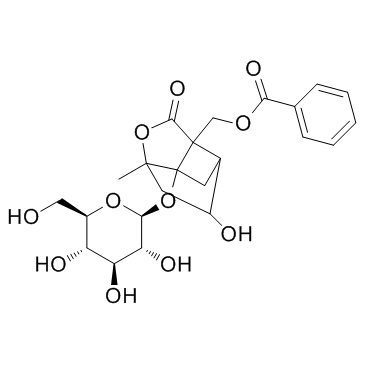albiflorin

albiflorin structure
|
Common Name | albiflorin | ||
|---|---|---|---|---|
| CAS Number | 39011-90-0 | Molecular Weight | 480.462 | |
| Density | 1.6±0.1 g/cm3 | Boiling Point | 722.1±60.0 °C at 760 mmHg | |
| Molecular Formula | C23H28O11 | Melting Point | N/A | |
| MSDS | USA | Flash Point | 248.9±26.4 °C | |
Use of albiflorinAlbiflorin is a major constituent contained in peony root; possesses therapeutic potential for neurodegenerative diseases.IC50 value:Target: in vitro: Albiflorin significantly ameliorated Glu-induced reduction of cell viability, nuclear and mitochondrial apoptotic alteration, reactive oxygen species accumulation, and B-cell lymphoma 2 (Bcl-2)/Bax ratio. Albiflorin also enhanced phosphorylation of AKT and its downstream element glycogen synthase kinase-3β, and this effect was abrogated by the AKT inhibitor LY294002 [1]. in vivo: Mice were exposed to X-ray radiation (400 Roentgen), and both mice and rabbits were intraperitoneally injected with cyclophosphamide (100.0 mg/kg) and cytarabine chloride (92.7 mg/kg), respectively, for 3 days to induce myelosuppression. Albiflorin was subsequently administrated intravenously at low (15.0 mg/kg for mice, 6.00 mg/kg for rabbits), intermediate (30.0 mg/kg for mice, 12.0 mg/kg for rabbits) and high (60.0 mg/kg for mice, 24.0 mg/kg for rabbits) doses, as well as orally (60.0 mg/kg for mice, 24.0 mg/kg for rabbits) for 7 days. Shenqi tablets were used as positive controls (oral administration of 936.0 mg/kg for mice, 336.0 mg/kg for rabbits). The administration of Albiflorin significantly ameliorated myelosuppression in all cases [2]. |
| Name | Albiflorin |
|---|---|
| Synonym | More Synonyms |
| Description | Albiflorin is a major constituent contained in peony root; possesses therapeutic potential for neurodegenerative diseases.IC50 value:Target: in vitro: Albiflorin significantly ameliorated Glu-induced reduction of cell viability, nuclear and mitochondrial apoptotic alteration, reactive oxygen species accumulation, and B-cell lymphoma 2 (Bcl-2)/Bax ratio. Albiflorin also enhanced phosphorylation of AKT and its downstream element glycogen synthase kinase-3β, and this effect was abrogated by the AKT inhibitor LY294002 [1]. in vivo: Mice were exposed to X-ray radiation (400 Roentgen), and both mice and rabbits were intraperitoneally injected with cyclophosphamide (100.0 mg/kg) and cytarabine chloride (92.7 mg/kg), respectively, for 3 days to induce myelosuppression. Albiflorin was subsequently administrated intravenously at low (15.0 mg/kg for mice, 6.00 mg/kg for rabbits), intermediate (30.0 mg/kg for mice, 12.0 mg/kg for rabbits) and high (60.0 mg/kg for mice, 24.0 mg/kg for rabbits) doses, as well as orally (60.0 mg/kg for mice, 24.0 mg/kg for rabbits) for 7 days. Shenqi tablets were used as positive controls (oral administration of 936.0 mg/kg for mice, 336.0 mg/kg for rabbits). The administration of Albiflorin significantly ameliorated myelosuppression in all cases [2]. |
|---|---|
| Related Catalog | |
| References |
| Density | 1.6±0.1 g/cm3 |
|---|---|
| Boiling Point | 722.1±60.0 °C at 760 mmHg |
| Molecular Formula | C23H28O11 |
| Molecular Weight | 480.462 |
| Flash Point | 248.9±26.4 °C |
| Exact Mass | 480.163147 |
| PSA | 172.21000 |
| LogP | -0.97 |
| Vapour Pressure | 0.0±2.5 mmHg at 25°C |
| Index of Refraction | 1.662 |
| Storage condition | ?20°C |
| Safety Phrases | 24/25 |
|---|---|
| RIDADR | NONH for all modes of transport |
|
Anti-adipogenic and antioxidant effects of the traditional Korean herbal formula Samchulgeonbi-tang: an in vitro study.
Int. J. Clin. Exp. Med. 8 , 8698-708, (2015) Here we report in vitro anti-adipogenic and antioxidant effects of Samchulgeonbi-tang (SCGBT), a traditional Korean herbal formula.3T3-L1 preadipocytes were differentiated into adipocytes with or with... |
|
|
Anti-inflammatory actions of herbal formula Gyejibokryeong-hwan regulated by inhibiting chemokine production and STAT1 activation in HaCaT cells.
Biol. Pharm. Bull. 38(3) , 425-34, (2015) Gyejibokryeong-hwan (GJBRH; Keishi-bukuryo-gan in Japan and Guizhi Fuling Wan in China) is a traditional herbal formula comprising five medicinal herbs and is used to treat climacteric syndrome. GJBRH... |
|
|
Detection of paeoniflorin and albiflorin by immunostaining technique using anti-paeoniflorin monoclonal antibody.
Phytochem. Anal. 24(2) , 124-8, (2013) Paeoniae radix is one of the most important crude drugs used in Kampo medicines (KMs). A part of its pharmaceutical properties is due to the presence of paeoniflorin (PF) and albiflorin (AF).For the s... |
| 7-Oxatricyclo[4.3.0.0]nonan-8-one, 9-[(benzoyloxy)methyl]-1-(β-D-glucopyranosyloxy)-4-hydroxy-6-methyl-, (1R,3R,4R,6S,9S)- |
| [(1R,3R,4R,6S,9S)-1-(β-D-Glucopyranosyloxy)-4-hydroxy-6-methyl-8-oxo-7-oxatricyclo[4.3.0.0]non-9-yl]methyl benzoate |
| Paeonia lactiflora Pall. |
| Alibiflorin |
| albiflorin |

